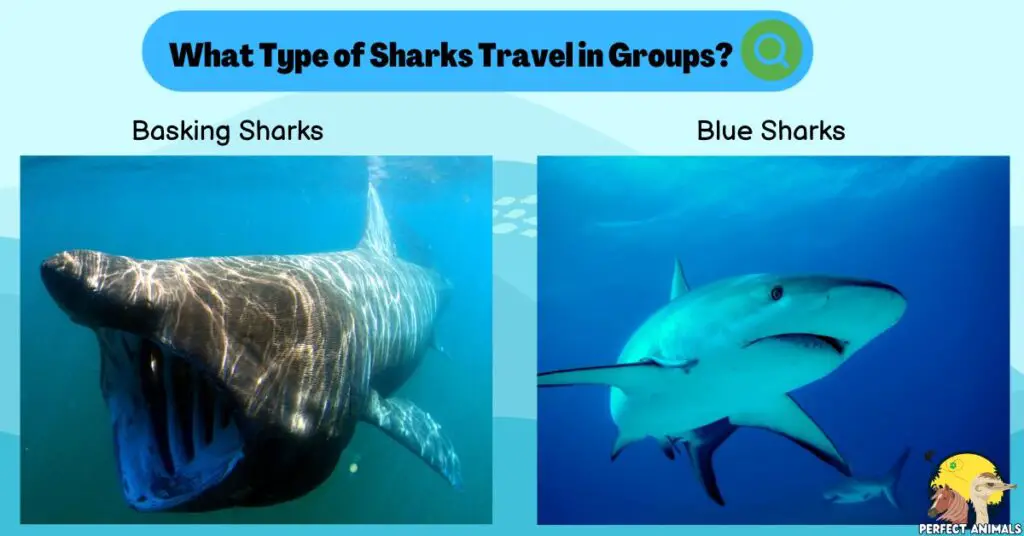Sharks gliding through the ocean are an iconic and sometimes terrifying sight. But do these powerful predators travel solo or in packs?
If you picture a great white shark circling alone before an attack, you might assume all shark species are loners.
However, some shark species are actually quite social! The idea that sharks are always solitary hunters is a common misconception.
In fact, certain shark species travel together in large groups throughout their lives while others prefer to go it alone.
In this article, we’ll look at which sharks like to stick together in packs and which ones embrace the lone wolf lifestyle.
You may be surprised to learn how many sharks enjoy a bit of camaraderie as they cruise through the oceans!
We’ll also explore possible reasons why some shark species developed social behaviors while others turned solitary over the course of evolution.
Read on to learn more about the group dynamics of these powerful ocean predators!
Do Sharks Travel in Packs or Alone?

When it comes to shark behavior, it’s not a simple yes or no answer to whether they travel in packs or alone.
Different shark species have different social tendencies. Some sharks are true loners who hunt, migrate, and live mostly in solitude. They only gather with other sharks to mate.
Other shark species, however, are highly social and swim together in schools or loose groups.
These group travelers are often found hunting, resting, migrating, and patrolling together.
Scientists theorize that traveling in packs may help certain shark species with activities like mating, migrating, finding food, and defending against predators.
The social structure of sharks varies greatly by species, based on evolutionary adaptations to their environments and lifestyles over millions of years.
So in short, while the iconic lone shark does exist, pack travelers are also familiar with the shark world!
You May Also Like – Do Seals Eat Penguins?
What is a Group of Sharks Called?
When sharks hang out together in groups, there are a few creative collective nouns used to describe them.
My personal favorite is a “shiver” of sharks. This name refers to a group of sharks gathered together or resting in one place, not actively swimming and hunting.
Other collective nouns for shark groups include “frenzy,” “herd,” “gam,” “school,” “pod,” “shoal,” “grind,” and “college.”
The term “school” is reserved for sharks actively swimming together in a coordinated way, like hammerheads or blacktips.
But a “shiver” evokes resting sharks congregating together, perhaps bobbing lazily as a group.
These collective nouns give a vivid image of how sharks’ social behaviors manifest.
What Type of Sharks Travel in Groups?
Not all sharks are loners – plenty of species travel together in packs.
Here are some of the most social shark species that you can often observe sticking together in groups.

Basking Sharks
Basking sharks are one of the more gregarious and group-oriented shark species.
These massive filter feeders, which can grow over 30 feet long, are regularly observed swimming together in large schools.
Scientists have documented schools of 100-500 basking sharks congregating in coastal areas to feed on dense patches of plankton.
Their wide open mouths allow them to filter enormous amounts of water for the tiny plankton they feast on.
Traveling in large groups may help them move as an efficient unit to better target plankton blooms.
Basking sharks also gather for migrations and seem to enjoy each other’s company when feeding and socializing.
When surrounded by other basking sharks, they exhibit interesting social behaviors like breaching together.
Blue Sharks
Blue sharks are also highly social creatures that swim together in sizable packs.
It’s common to see groups of 10-20 blue sharks sticking together, though schools of 100 or more have been observed as well.
They move together when hunting for squid, fish, and other prey but seem to enjoy each other’s company during migrations and resting periods too.
Since blue sharks cover such vast distances in their migrations across ocean basins, this may be part of the reason they travel in groups.
Their large packs may also deter predators. Blue sharks demonstrate fascinating social dynamics within their schools, with females playing central roles.
Blacktip Sharks
Blacktip sharks congregate in exceptionally large groupings, making them one of the most social and gregarious shark species in the oceans.
In areas like the Caribbean and tropical Pacific, you can often observe massive groups or schools of hundreds or even thousands of blacktip sharks.
The schooling behaviors are thought to relate to mating activities.
But blacktips also cooperate when hunting fish and may gain certain advantages sticking together in such huge packs.
Within these enormous schools, blacktips have complex social hierarchies and relationships.
They are constantly interacting with each other through behaviors like fin slapping.
Their social bonds form as juveniles and last throughout their long lives.

Sand Tiger Sharks
The shallow, coastal habitats of sand tiger sharks are perfect places to observe their intriguing schooling behaviors.
Groups of up to 50 sand tiger sharks, sometimes even more, can often be spotted swimming, hunting, and resting together.
Their unique social activities include ritualized grouping behaviors, parallel swimming, and even “stacked swimming” with their bodies touching.
Sand tigers seem to prefer companionship and will wait for straggler members of their group.
Their social structure provides advantages for finding prey, reproducing, and even collective resting.
These semi-nomadic sharks migrate together each winter as well.
Scientists are still learning more about their advanced cognitive abilities and social bonds.
Scalloped Hammerhead Sharks
With their signature hammer-shaped heads, scalloped hammerheads are one of the more recognizable social shark species.
During summer months, they gather in enormous schools of hundreds or even thousands of individuals around seamounts and offshore islands.
Scientists think these summer gatherings relate to mating rituals. Their large social groups may also make it easier for them to migrate enormous distances across open oceans.
Within scalloped hammerhead schools, there are smaller subgroups where the sharks interact using touches, chases, and displays to establish social hierarchies.
Their communal lifestyle gives scalloped hammerheads certain social advantages for finding prey, reproducing, and more.
You May Also Like – Do Turtles Have Teeth?
How Many Sharks Travel in a Group?
The number of sharks that gather in groups varies quite a bit depending on the species.
Some sharks form enormous schools containing hundreds or even thousands of individuals at times.
The largest aggregations have been observed with blacktip sharks – schools of up to 2000 blacktip sharks at once have been reported in areas like French Polynesia.
Scalloped hammerheads also congregate in huge seasonal groups numbering in the hundreds or thousands around offshore islands and seamounts.
Other highly social species like blue sharks and sand tigers travel in slightly smaller yet still sizable schools typically numbering in the tens to hundreds of sharks.
Even normally solitary sharks like great whites may temporarily gather in significant concentrations of up to 60-100 sharks in certain feeding hotspots.
While not all shark groupings represent complex social behaviors, many species do stick together long-term in cohesive social groups and schools.
How Long Do Sharks Travel in Groups?
For shark species that demonstrate social behaviors, traveling and staying together in groups can last anywhere from a few days to many years.
In some cases, the groupings are temporary based on short-term needs like finding abundant food.
For example, great white sharks may congregate in the hundreds for periods of weeks or months in locations with large seal colonies, but then disperse after.
Other species like scalloped hammerheads form huge seasonal social groups, gathering in the summer for mating and dispersing again in fall and winter.
However, some highly social shark species maintain long-term bonds and travel together in cohesive groups for years, even decades.
Sand tiger sharks exhibit complex social behaviors and relationships that last throughout their lifetimes of up to 45 years.
Blacktip reef sharks also form persistent social groups with long-term associations between individuals that can persist for 16-22 years.
So while not all shark groupings are permanent, some species really do prefer the company of their fellow sharks for life.
Related Article – Do Fish Blink?
Do Sharks Live in Groups or Alone?
Most shark species tend to be solitary rather than social.
While some sharks do congregate in groups for feeding, migrating, or mating, they ultimately spend much of their time scattered and alone in the expanses of the oceans.
Sharks like great whites, makos, and whale sharks live entirely solitary existences, only coming into contact with others of their kind to mate. They hunt, feed, rest, and migrate independently.
Even sharks that form temporary social groups usually separate again outside of seasonal gatherings or sporadic feeding frenzies.
Reef sharks like blacktips that school together still spend considerable time alone each day as well.
Only a select few shark species exhibit truly group-living social structures, like gray reef sharks sharing home ranges long-term.
But in general, despite brief periodic gatherings, sharks adopt largely solitary living habits – the archetypal lone wolf roams the seas.
Which Shark Travels Alone?
While some sharks are highly social, other species embrace the solitary lifestyle. These lone wolves of the shark world are often found cruising the oceans independently rather than in groups.
Here are some sharks known for traveling alone.
Great White Sharks
Few sharks epitomize the solitary shark image quite like the great white.
They spend nearly their entire lives alone, hunting, feeding, migrating, and existing completely independently.
The only exceptions are temporary gatherings around rich food sources and when mating.
Great whites are highly territorial as well, staking out large home ranges.
Their lone wolf tendencies relate to their hunting style – stealthily ambushing seals and sea lions is a solo endeavor.
Their minimal social contact stems from simply not needing others of their kind to thrive.
Whale Sharks
Despite being the largest fish in the oceans, whale sharks cruise through tropical seas almost entirely alone.
They migrate immense distances, up to 13,000 miles, in solitude.
While whale sharks may feed in areas alongside others, they do not actively congregate in schools.
Each individual feeds alone even when many are in one area together.
Their huge size and docile filter-feeding strategy means they have little need for companionship or group behaviors.
Whale sharks simply spend their long lives, up to 130 years, roaming the warm oceans peacefully but solitarily.
Mako Sharks
Makos are one of the fastest and most active ocean predators, and they channel this into a highly migratory, solitary lifestyle.
They embark on long migrations and cover vast distances completely alone.
The only gatherings they are observed in relate to mating aggregations.
But otherwise, makos hunt, feed, rest, and traverse thousands of miles independently.
Their high metabolism and consistent movement patterns mean they have little reason to be sedentary with other makos.
They live lives of perpetual motion and seclusion except for fleeting encounters to mate. Scientists satellite track makos crossing entire oceans without any significant contact with others.
Bull Sharks
Despite living in shallow, coastal habitats, bull sharks adopt predominantly solitary behaviors rather than schooling.
They patrol estuaries, bays, and shallow reef systems alone when not mating.
Bull sharks are highly territorial as well, maintaining individual home ranges though with some overlap.
Their ability to tolerate freshwater allows them to swim far up rivers away from other sharks.
While bull sharks may briefly converge in optimal hunting spots, they mostly spend their time alone cruising the coasts.
Their aggression and solitary personality earn them a reputation similar to great whites among the most territorial lone sharks.
Greenland Sharks
In the icy darkness of the Arctic and North Atlantic oceans, Greenland sharks embodied isolated, solitary existences.
They spend most of their lives alone in deep waters between 300-2,200 meters beneath the surface.
Only rarely do they congregate with other Greenland sharks to possibly mate.
But otherwise, they are totally solitary hunters and scavengers.
Their sluggish metabolism and incredible longevity, over 400 years, means they patiently roam the cold depths alone for centuries.
Until recently, Greenland sharks were extremely mysterious due to their remote frozen habitats and cryptic lifestyle devoid of social contact.
Do Sharks Stay In the Same Area?
Shark species exhibit a high diversity of movement patterns, with some remaining in a localized area while others roam across entire ocean basins.
Many coastal shark species like blacktip reef sharks, nurse sharks, wobbegongs, and epaulet sharks establish home ranges where they regularly hunt, rest, and patrol.
However, they may still migrate seasonally or in relation to certain life stages like breeding.
Oceanic sharks like makos, great whites, and whale sharks are highly migratory and cover vast distances, though they return to certain hotspots.
Some deepwater sharks have minimal ranges, like bluntnose sixgill sharks staying near submarine canyons.
A few shark species even display homing abilities to periodically return to their home after long journeys away.
So while some shark species are homebodies sticking to a familiar local area, wide-ranging movements are also common as sharks explore new territories.
Overall there is no simple answer, as movement patterns vary based on habitat, hunting methods, reproductive cycles, and other factors.
Both resident sharks with localized ranges and wandering sharks with enormous ranges play important roles in ocean ecosystems.
Final Thoughts
The social lives of sharks are as diverse and fascinating as the sharks themselves.
While the stereotyped lone shark certainly exists, we’ve also seen that group behaviors are common among many species.
Sharks have evolved over millions of years to adopt social or solitary habits that suit their unique lifestyles and environments.
For solitary sharks like great whites and makos, their independence relates to hunting needs or simple personality preferences.
But for gregarious sharks like blacktips and hammerheads, advantages like easier mating, migration, defense, and hunting may explain their social bonds.
There is still much to learn about the nuances of how different sharks interact and organize.
In the end, both lone sharks and group sharks play critical roles as ocean predators.
Their social structures stem from adaptations over eons to thrive in their aquatic realms.
There is room in the seas for sharks content in their own company as well as those who prefer companionship. The mysteries of sharks never cease to amaze.
FAQs
Do bull sharks travel in groups?
No, bull sharks are typically solitary and do not travel in organized social groups. They may temporarily gather around food sources.
Do great white sharks travel in groups?
No, great white sharks spend nearly all their time alone and only gather with other sharks for mating purposes. They are archetypal lone sharks.
Do hammerhead sharks travel in groups?
Yes, scalloped hammerhead sharks in particular form large seasonal social groups numbering in the hundreds or thousands around offshore islands and seamounts.
Do basking sharks travel in packs?
Yes, basking sharks commonly travel together in large groups or schools of 100-500 individuals when feeding on plankton blooms.
Do thresher sharks travel in packs?
No, thresher sharks are not known to form social groups and appear to spend most of their time solitary.
When do sharks travel in groups?
Some shark species travel in groups during activities like feeding, migrating, mating, and for defense or protection. Group behaviors vary by species.
Do sharks hunt in groups?
Some shark species like blacktips, hammerheads, and reef sharks do appear to cooperatively hunt in loosely organized groups at times. But many sharks hunt completely alone.
Resources – (for further reading)
Psychology Today – The Sharks That Hunt in Packs
The Conversation – Great white sharks occasionally hunt in pairs
Britannica – Shark – Migration, Socialization, Hunting

Sofi has worked as an educator at the Miami Seaquarium, where she conducted educational programs about marine life. In her free time, she contributes to our platform, sharing her passion for marine ecosystems and their conservation.

